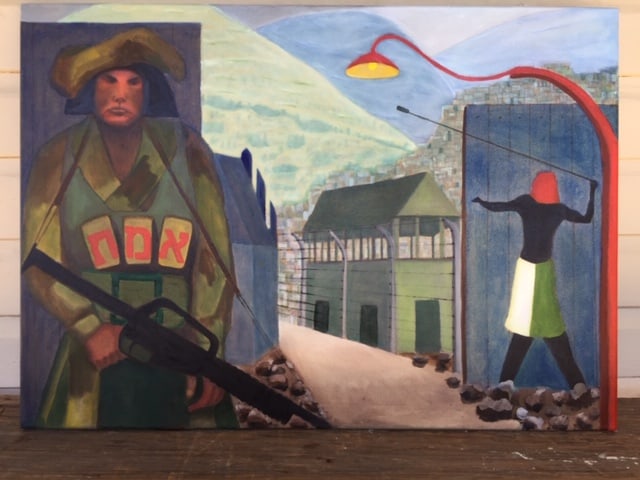‘Golem’ painting 2019, (600 x 860) oil on canvas.
The figure on the left of the painting is based on the golem character from The Golem, How He Came into the World, a 1920 German expressionist film by Paul Wegener. The film is one of the high points of the period (roughly 1880-1930) when there was interest by secular writers, both Jewish and non-Jewish, in the medieval golem legend, including Gustav Meyrink’s, Der Golem novel of 1915, and Karol Capek’s, Rossums Universal Robot (R.U.R.) play of 1921. The legend tells of the creation out of earth or mud by rabbis of an artificial human to protect Jewish people during pogroms. Golem stories presage the Sorcerer’s Apprentice poem by Goethe of 1797, Mary Shelley’s Frankenstein novel of 1818, and other literary, musical and theatrical treatments of the golem legend in the latter 19th and early 20th centuries. The character named Gollum in the Lord of the Rings cycle may be an unintended coincident, but would a scholar of Tolkien’s erudition been unaware of the earlier golem legend?
I’ve depicted the golem in the painting in camouflage patterning, and a gun and head gear, typical Israeli military uniform. These visual metaphors link the military institutions ‘protecting’ the Jewish state with the golem, the artificial human that protects Jews.
The Hebrew letters on the golem’s uniform, reading right to left, spell the word ‘emet’ (truth) and is one of the magical incantations that are said to have been recited when creating a golem out of earth. The word emet (אֱמֶת) contains the first, middle and last letters of the Hebrew alphabet, indicating that truth encompasses all things and endures from the beginning (א) to the end (ת). Because the role of God is usurped by giving life to inanimate matter, invariably the golem runs amok (a comparison I make between the golem and the Israeli state in the painting). The golem thus has to be disabled or killed, which is effected by removing or changing the word or sign on its body that animates it. If the aleph, the first letter of the alphabet that represents the breath of or awareness of God (the letter on the golem’s right in the painting) is removed the word becomes ‘met’ meaning (death) and the golem dies. The famous 16th century Rabbi Lowe of Prague disabled his golem in a similar way and according to myth its earthen body remains in the attic of Prague’s Altnueschul synagogue, the rear of which is shown immediately on the right of the golem in the painting.
The red lamp post and lamp that frame the right side of the painting extending into the centre of the composition that ‘illuminates the scene’ and the barracks opposite the Altnueschul are concentration camp imagery. This imagery refers to a number of ideas that I believe help understand the Israel/Palestine conflict. Firstly, the grotesque irony that the ‘Jewish’ state, despite the long history of Jews as victims of communal violence, pursues violent policies to dispossess and concentrate the Palestinian population under its control; secondly, the lager (prison)-like mentality affecting many Israelis and Jewish communities resulting from the manipulation of Holocaust memory and fear of anti-Semitism; thirdly, to divert attention from the denial of Palestinian civil and national rights; and finally, to justify an increasingly strident ethno-chauvinism in Israel and amongst its Jewish and evangelical Christian supporters.
The Palestinian figure with slingshot opposite the golem inverts the biblical David and Goliath story. Both the Golem and the Palestinian figures are framed by segments of the West Bank dividing wall giving the composition its contemporary setting.
Martin Munz

